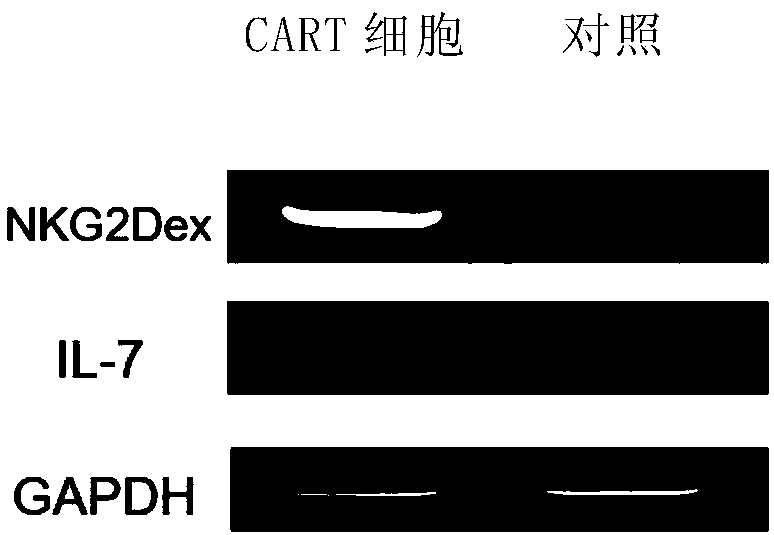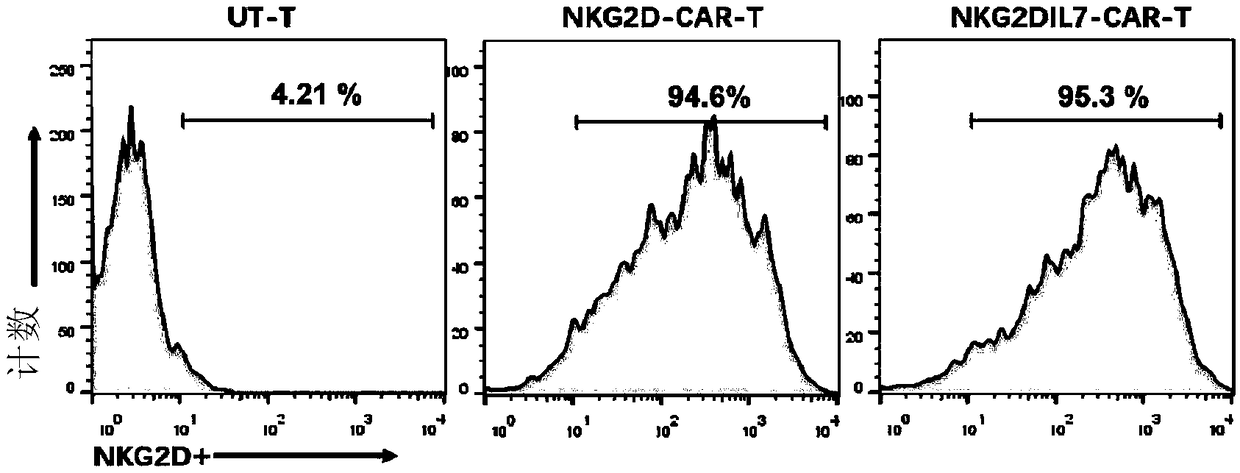NKG2D-CAR-T (Chimeric Antigen Receptor-T) cell of co-expression cell factor IL-7 and application thereof
A co-expression and host cell technology, applied in the field of biomedicine, can solve problems such as deletion
- Summary
- Abstract
- Description
- Claims
- Application Information
AI Technical Summary
Problems solved by technology
Method used
Image
Examples
Embodiment 1
[0205] Example 1 Acquisition of NKG2D extracellular segment gene sequence and human IL-7 gene full-length sequence
[0206]Check the CDS region of the full-length NKG2D gene through the website https: / / www.ncbi.nlm.nih.gov / pubmed / , and find the extracellular region of the NKG2D protein at https: / / www.uniprot.org / , Find the corresponding extracellular segment gene sequence in the NKG2D full-length gene sequence. Since NKG2D protein is a type II transmembrane protein, its extracellular segment sequence is located at the N-terminal and does not contain a signal peptide. Therefore, we added the signal peptide sequence in the existing CD19-CAR to the front end of the NKG2D extracellular segment sequence. Use SnapGene software to design and synthesize primers (the primers contain cell peptide sequences) in the company, use human T cell cDNA as a template, amplify the extracellular segment of NKG2D by RT-PCR, and sequence the RT-PCR products to obtain Sig- The sequence of the extrac...
Embodiment 2
[0214] Example 2 Construction of PCDH-NKG2D-CAR and PCDH-NKG2DIL7-CAR vectors
[0215] The obtained sigNKG2DEX sequence and the already constructed second-generation CAR sequence (CD8-CD3zeta-4-1BB) (obtained from Shanghai Bangyao Biotechnology Co., Ltd.) were connected together by overlapping PCR. After RT-PCR and sequencing identification, it was confirmed that the construction was successful, and the PCDH-NKG2D-CAR vector was obtained. On the basis of this vector, the IL-7 gene sequence was constructed between CAR and GFP by overlapping PCR, and after RT-PCR and sequencing identification. It is confirmed that the construction is successful, and the PCDH-NKG2DIL7-CAR vector is obtained, and the structure diagram is as follows figure 1 shown.
Embodiment 3
[0216] Embodiment 3 virus packaging
[0217] Amplification and viral packaging of PCDH-NKG2D-CAR and PCDH-NKG2DIL7-CAR plasmids
[0218] 3.1 Plasmid transfection
[0219] Put the plasmid, PEI, and Opti-MEM medium at room temperature for 5 minutes;
[0220] 2) Take 436 μl of Opti-MEM into a 1.5ml EP tube, then add 64 μg PEI, mix well, and let stand at room temperature for 5 minutes;
[0221] 3) Take 12 μg of vector plasmids PCDH-NKG2D-CAR and PCDH-NKG2DIL7-CAR, 8 μg of psPA×2, 4 μg of pMD2.G, add Opti-MEM to 500 μl, and let stand at room temperature for 5 minutes;
[0222] 4) Add the prepared PEI-Opti-MEM solution into the Opti-MEM containing the plasmid, and let stand at room temperature for 20 minutes;
[0223] 5) Slowly drop 1ml of the DNA / PEI mixture into the 293T Petri dish laid out the day before, mix gently, incubate in a 37°C incubator, replace with fresh medium after 6-8h, and put it in a 37°C incubator to continue incubating .
[0224] 3.2 Virus collection and co...
PUM
 Login to View More
Login to View More Abstract
Description
Claims
Application Information
 Login to View More
Login to View More - R&D
- Intellectual Property
- Life Sciences
- Materials
- Tech Scout
- Unparalleled Data Quality
- Higher Quality Content
- 60% Fewer Hallucinations
Browse by: Latest US Patents, China's latest patents, Technical Efficacy Thesaurus, Application Domain, Technology Topic, Popular Technical Reports.
© 2025 PatSnap. All rights reserved.Legal|Privacy policy|Modern Slavery Act Transparency Statement|Sitemap|About US| Contact US: help@patsnap.com



